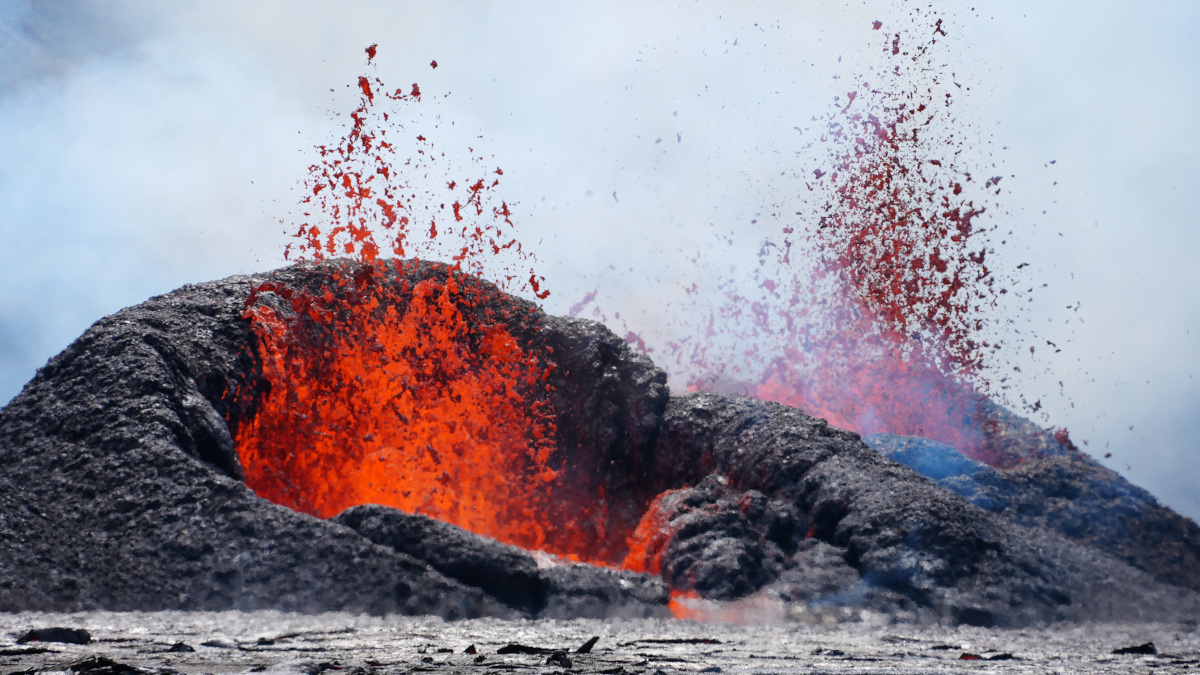
USGS: “This telephoto view shows one of the erupting vents in Kīlauea caldera. Lava fountain heights at the vents reached up to about 10-15 meters (32-50 feet) and the horseshoe-shaped spatter ramparts that have accumulated on the south/downwind side of the vents remain 20 meters (66 feet) high.” (USGS photo by M. Patrick)
(BIVN) – On Friday, as the eruption of Kīlauea volcano continues at the summit caldera, the USGS Hawaiian Volcano Observatory made an adjustment to the way it formats its daily update, breaking the activity report down using bullet points.
From the September 15th USGS HVO update:
Activity Summary: The Kīlauea summit eruption that began on September 10th continues this morning. Eruptive activity is confined to the downdropped block and Halemaʻumaʻu crater within Kīlauea’s summit caldera. No unusual activity has been noted along Kīlauea’s East Rift Zone or Southwest Rift Zone.
Summit Eruption Observations: Several roughly east-west oriented vents continue to erupt on the western side of the downdropped block within Kīlauea’s summit caldera and are generating lava flows onto Halema‘uma‘u crater floor. Effusion rates continue to decrease, but remain significant.
• Vigorous spattering is restricted to the westernmost large spatter cone with fountains 10-15 meters. Minor spattering is occuring within the next cone to the east, but the fountains remain mostly below the rim of its cone. Lava continues to flow from these and potentially several of the other cones.
• Pāhoehoe lava flows continue to travel in north and west directions from the vents, around elevated ground from the 1982 eruption, and onto Halema‘uma‘u crater floor. Overnight webcam imagery shows that the area of active lava remains restricted to the western part of the downdropped block and the northeastern parts of Halema‘uma‘u. This area of active lava does not appear to have changed significantly in size over the past 24 hours. Numerous oozeouts of lava were visible over other parts of Halema‘uma‘u crater floor overnight.
• Field crews yesterday reported that lava fountain heights at the vents reached up to about 10-15 meters (32-50 feet) and the horseshoe-shaped spatter ramparts that have accumulated on the south/downwind side of the vents remain 20 meters (66 feet) high.
• The laser rangefinder is aimed at a western portion of Halema‘uma‘u, not near the new eruptive activity, and recorded about 10 meters (33 feet) of uplift to this locality since the eruption started. This demonstrates that a significant amount of lava has intruded beneath the pre-existing crust within Halema‘uma‘u.
• Volcanic gas emissions in the eruption area are elevated; winds yesterday, September 14, prevented measurements of a suflur dioxide (SO2) emission rate. The most recent SO2 emission rate of 20,000 tonnes per day was measured the afternoon of September 13. This is down significantly from the 190,000 tonnes per day measured just after the onset of the eruption on Sunday, September 10th.
• A live-stream video of the eruption is available (here).
• More eruption information is available (here).
Summit Observations: Summit tilt has remained mildly deflationary over the past 24 hours. Summit seismic activity is dominated by eruptive tremor (a signal associated with fluid movement) with very few volcano tectonic earthquakes.
Rift Zone Observations: No unusual activity has been noted along the East Rift Zone or Southwest Rift Zone; steady rates of ground deformation and seismicity continue along both. Measurements from continuous gas monitoring stations downwind of Puʻuʻōʻō in the middle East Rift Zone—the site of 1983–2018 eruptive activity—remain below detection limits for SO2, indicating that SO2 emissions from Puʻuʻōʻō are negligible.
Hazard Analysis: Eruptive activity is occurring on the downdropped block and Halemaʻumaʻu crater, within Kīlauea’s summit caldera and in the closed area of Hawaiʻi Volcanoes National Park. During Kīlauea summit eruptions, the high level of volcanic gases—primarily water vapor (H2O), carbon dioxide (CO2), and sulfur dioxide (SO2)— and fine volcanic particles are the primary hazards of concern, as these hazards can have far-reaching effects downwind.
As SO2 is released from the summit, it reacts in the atmosphere to create the visible haze known as vog (volcanic smog) that has been observed downwind of Kīlauea. Vog creates the potential for airborne health hazards to residents and visitors, damages agricultural crops and other plants, and affects livestock. For more information on gas hazards at the summit of Kīlauea, please see (this link). Vog information can be found (here).
Strong winds may waft fine rock particles to areas downwind of erupting vents. People should minimize their exposure to these fine volcanic particles, which can cause skin and eye irritation. Reports from Hawaiian Volcano Observatory field crews indicate that fine particles of Pele’s Hair and other tephra are being deposited in the area near the Keanakāko‘i Overlook, which is approximately half a mile (about 1 km) from the eruption site. Hawaiʻi Volcanoes National Park has closed the Keanakāko‘i Overlook to the public at this time.
Other significant hazards also remain around Kīlauea’s summit from Halemaʻumaʻu crater wall instability, ground cracking, and rockfalls that can be enhanced by earthquakes within the area closed to the public. This underscores the extremely hazardous nature of the rim surrounding Halemaʻumaʻu crater, an area that has been closed to the public since early 2008.

by Big Island Video News7:05 pm
on at
STORY SUMMARY
HAWAIʻI VOLCANOES NATIONAL PARK - On Friday, the USGS Hawaiian Volcano Observatory made a small change to its daily Kilauea eruption update.